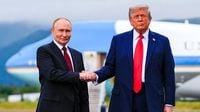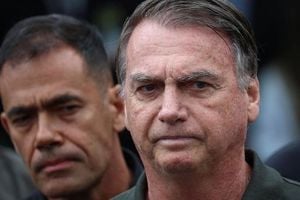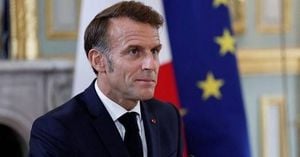As Ukraine’s war with Russia grinds on into its fourth year, a new funding mechanism and shifting international strategies are reshaping the landscape of military aid and diplomacy. Both the United States and European allies are recalibrating their roles, balancing domestic pressures, battlefield realities, and the enduring hope for peace—even as the fighting shows no sign of abating.
On September 17, 2025, Ukrainian President Volodymyr Zelenskyy announced that Ukraine expects to have amassed around $3.5 billion by October in a special fund dedicated to purchasing U.S. weapons and sustaining its defense against Russia’s invasion. This fund, known as the Prioritized Ukraine Requirements List (PURL), pools contributions from NATO members—excluding the United States itself—to finance American-made military equipment, according to the Associated Press. Zelenskyy explained, “We received more than $2 billion from our partners specifically for the PURL program. We will receive additional money in October. I think we will have somewhere around $3.5–3.6 billion.”
While Zelenskyy declined to give a full breakdown of the first weapons shipments, he did confirm that they would include missiles for the Patriot air defense systems and munitions for the High Mobility Artillery Rocket Systems (HIMARS). Both systems have become cornerstones of Ukraine’s ability to defend its cities from missile attacks and strike back at Russian positions with precision. “We will definitely have Patriot and HIMARS missiles,” Zelenskyy said at a press conference, as reported by Fox News.
The PURL initiative represents a significant policy shift. Rather than sending cash directly to Kyiv, allied governments commit funds that Washington uses to procure weapons from U.S. defense companies. Germany, Poland, the United Kingdom, and other NATO members are believed to be leading contributors, although the exact breakdown remains undisclosed. The U.S. approved two $500 million weapons packages under the PURL program in early September, marking the first new arms shipments since the Pentagon paused deliveries in July due to strains on its own munitions stockpiles.
This new approach also allows President Donald Trump’s administration to continue supporting Ukraine’s war effort while deflecting criticism from lawmakers wary of further taxpayer-funded aid. A senior administration official told Fox News Digital, “The Department of War has facilitated this first sale of weapons in line with President Trump’s America First priorities and efforts to bring this brutal war, which was brought on by Joe Biden’s incompetence, to an end.”
Trump himself, speaking at a joint press conference in London with UK Prime Minister Keir Starmer on September 15, acknowledged the complexity of the conflict and the limits of U.S. engagement. “The one that I thought would be easiest would be because of my relationship with President Putin,” Trump remarked. “But he's let me down. He's really let me down. Was going to be Russia and Ukraine. But we'll see how that turns out.” In a candid moment, Trump reflected on the toll of the war: “It’s millions of people have died in that war. Millions of souls. And they're not American soldiers, mostly soldiers. As you know, the soldiers are being killed at levels nobody's seen since the Second World War, but they're being, they're being killed. And I feel I have an obligation to get it settled for that reason.”
Despite months of U.S.-led peace negotiations—including an Alaska summit between Trump and Russian President Vladimir Putin—no breakthroughs have emerged. Kremlin spokesman Dmitry Peskov reiterated Russia’s official stance on September 17, telling reporters, “We remain open for negotiations and prefer to settle the Ukrainian crisis by political and diplomatic means.” Yet, on the ground, the violence persists: Russian overnight aerial attacks disrupted Ukrainian rail and power services, and a Russian glide bomb struck a town in the southern Kherson region, wounding three women and a three-year-old girl, according to Ukrainian officials.
Trump’s decision to rely on allied contributions rather than seek additional congressional appropriations has not gone unnoticed. It’s a move that appeals to those in Washington eager to limit U.S. spending abroad, while still maintaining American leadership in arming Ukraine. Secretary of State Marco Rubio noted that Trump and Zelenskyy may meet on the sidelines of the United Nations General Assembly next week, although Russia will be represented by Foreign Minister Sergey Lavrov rather than Putin himself.
Meanwhile, the U.S. defense industrial base is feeling the strain. The Pentagon is racing to double its monthly artillery shell output, but leaders admit it will take years to replenish depleted stockpiles—especially as the U.S. juggles support for Ukraine, Israel, and operations in the Middle East. Army Chief of Staff Gen. Randy George has warned about the unsustainable practice of using expensive interceptors against cheap Russian drones and artillery. “What we don't want to do is shoot $3 million missiles at $50,000 drones or $10,000 drones,” he said. The Army’s goal is to leverage advanced automation to double the output of 155mm rounds and drive innovation toward more cost-effective defenses.
In another strategic move, a new U.S.-Ukraine fund aimed at stimulating investment in Ukraine’s mineral sector is set to launch with $150 million in seed capital—$75 million from the U.S. International Development Finance Corporation and an equal amount from Ukraine. Ukrainian Economy Minister Oleksii Sobolev described the fund as a “beacon” for future international support, saying, “This is enough to launch the first significant investments.” The deal, signed in April, gives the U.S. preferential access to new Ukrainian mining projects and is intended to spur reconstruction while enabling continued military aid. Prime Minister Yuliia Svyrydenko said the fund would initially focus on energy, infrastructure, and critical mineral projects, aiming to finance three projects by the end of 2026.
While the prospect of peace remains elusive, the current strategy of pooled allied funding and targeted investment seems poised to sustain Ukraine’s war effort and postwar recovery. The coming months will test whether these new approaches can deliver the stability and security so many on both sides of the Atlantic crave.
For now, Ukraine’s arsenal is set to grow, its economy is being primed for reconstruction, and the diplomatic chessboard continues to shift—each move watched closely by a world hoping for an end to Europe’s deadliest conflict in generations.




